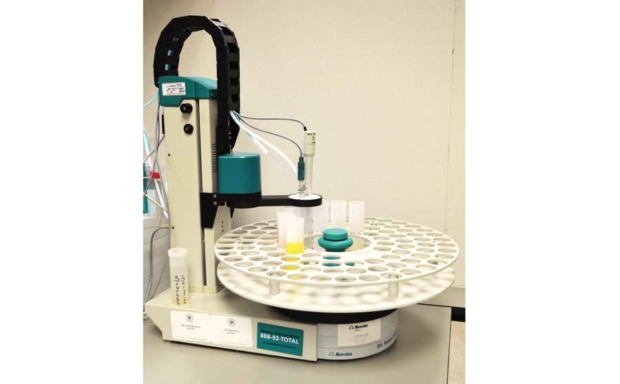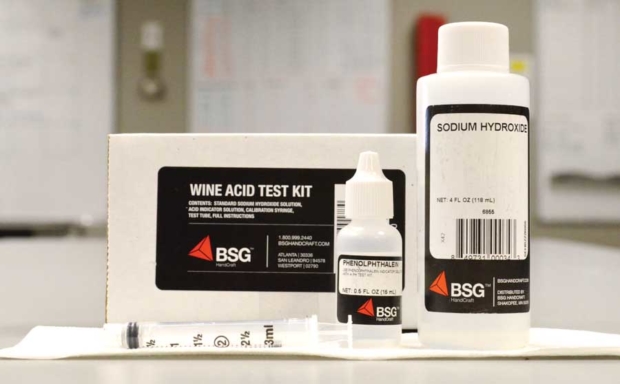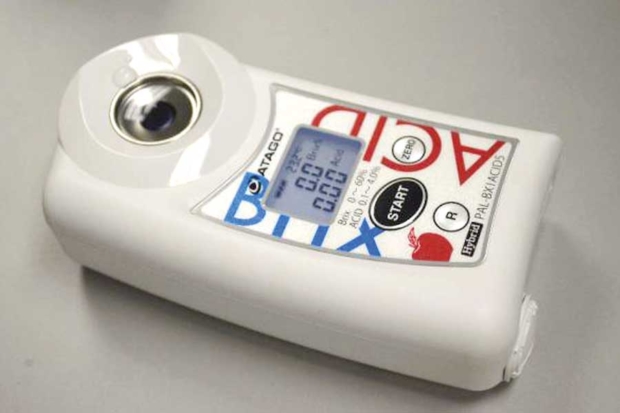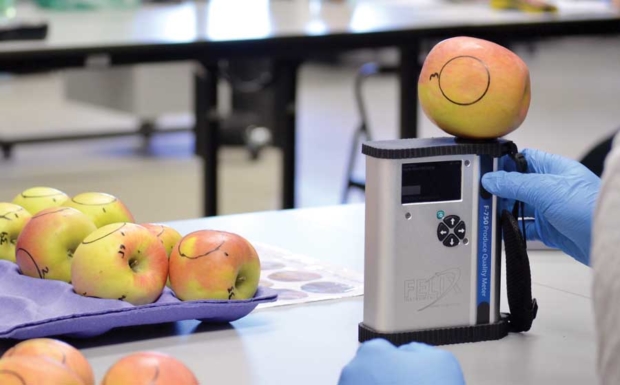Growers and packers require accurate information about fruit maturity over the course of a season — on the tree prior to harvest, at receiving in the storage facility and throughout storage — to ensure a year-round supply of high-quality fruit.
At the same time, postharvest losses must be minimized to ensure financially sustainable packouts and returns for growers.
Recently, several devices to assist in determining some of the commonly used fruit quality parameters, such as firmness, soluble solids content (SSC), titratable acidity (TA), dry matter content (DMC) and skin color, have been introduced to the market.
The Washington Tree Fruit Research Commission (WTFRC), under the leadership of project manager Ines Hanrahan, has tested several such devices. The following summarizes those findings without endorsing any one product over another.
TR Turoni DA-Meter

(All images below courtesy WTFRC)
The DA-meter nondestructively measures the difference of absorbance (as IAD) of two wavebands of light between 670 and 720 nm, which is used to calculate relative chlorophyll content, an indicator for the maturity progression of the fruit.
However, while the parameter correlates closely with the SSC, TA and firmness for some varieties and regions, no major correlations have been found in the Pacific Northwest for Honeycrisp.
When using the DA-meter in orchards, direct sunlight can interfere with the readings, so the WTFRC team has retrofitted a visor to the instrument to eliminate fluctuations in readings caused by light (see inset photo at right).
The DA-meter alone cannot replace the most common destructive maturity indicators (SSC, starch, firmness), but it can be used as an additional parameter to track the speed of maturity progression, the spread of maturity within a tree or a block, and to separate lots for storage.
Currently scientists are using the DA-meter to study the ripening behavior of pears.
Metrohm Titrator

The Metrohm Titrator measures TA content. Due to its purchase price, it is useful in situations that require a high sample throughput (such as larger packing house operations or research stations).
Also, the Metrohm requires systematic calibration and maintenance under lab conditions.
Titration with the Metrohm is the standard method to measure the TA content of all experimental fruit at the WTFRC.
Accuvin Titratable Acidity Test Kit

Currently, the Accuvin acidity tube test is the fastest and easiest method to determine apple fruit acidity levels of all test kits evaluated by WTFRC to date.
Due to its lower accuracy, this test should be used if gaining information about the acidity range is more important than an exact value, such as when trying to group lots of Honeycrisp apples based on high or low TA levels for different storage durations.
We noted that this test requires minimum training and can be performed in the field or at receiving.
BSG wine acid test

In general, the wine acid test from BSG is cheaper to purchase than the Accuvin tube test.
However, due to the additional equipment needs and the higher time requirement to perform the actual test, the overall operating costs are higher.
Also, this test is not suitable for field use.
Atago PAL-BX|ACID5

Atago’s PAL-BX|ACID5 is able to measure the SSC and the TA one after another from the same juice sample.
However, in order to be able to measure the TA content after the SSC measurement, a 1:50 dilution has to be made.
This step can lead to calculation errors. Overall, the device showed an accuracy of about 78 percent.
Felix F-750

The F-750 allows the nondestructive measurement of certain parameters.
However, a model has to be created for each parameter and each lot of fruit separately. During a proof of concept study, the WTFRC attempted to develop a firmness, DMC, TA, SSC and DA model for Fuji, Honeycrisp and Cosmic Crisp apples.
Our results showed it was possible to create DA and dry matter models. However, no model could be created for firmness, SSC and TA with the current software.
More specific research is required to see if there is a need to develop models for individual varieties, pre- and postharvest measurements and to work out specific recommendations for the measuring procedure.
The device is not currently ready for field application.
Summary
While there was little progress in the commercial development of new devices to help growers and packers accurately, quickly and economically determine common maturity parameters, several options have become available in recent years.
Some devices, such as the Accuvin Titratable Acidity Test Kit, should be able to be used successfully without any problem.
Others, like the Felix F-750 are very promising, but will need further refinement in order to be easily adoptable for quality control personnel or others. •
– by Ines Hanrahan and Stefan Röder, Washington Tree Fruit Research Commission






[…] This Good Fruit Grower article published in 2016 describes several of the devices and techniques available to determine fruit maturity […]